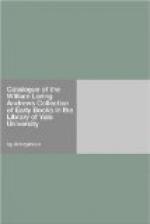26. INTRATIONES. London, Richard Pynson, 28 Feb. 1510.
Fol. 1^a, TITLE: INtrationu_m_ excellentissimus liber perq_uam_ necessarius o_mn_ibus leg_is_ hominib_us_: fere in se continens o_mn_em medullam diversa_rum_ materia_rum_ ac pl_ac_ito_rum_ tam realiu_m_, personalium, q_uam_ mixt_orum_. Necno_n_ multorum breuium tam executionu_m_ q_uam_ aliorum valde vtilium illis hunc librum inspecturis aut inscrutandis. Que quide_m_ supradicta facilit_er_ possunt inveniri p_er_ indice_m_ alphabeticu_m_ p_er_uigila_n_ti studio co_n_fectu_m_ & p_er_ ordine_m_ l_itte_raru_m_ redactu_m_... Fol. 1^b, [Full page woodcut of the king’s arms crowned, supported by a dragon and a greyhound, with a portcullis on either side and a rose and two angels above.] Fol. 2^a: Intrationu_m_ libri Index Alphabetic_us_. Fol. 10^b: Finis tabule Intrationum. Fol. 193^a, COLOPHON: Explicit opus excellentissimu_m_ & perutile in se continens multas materias o_mn_ibus leg_is_ ho_min_ib_us_ p_er_q_uam_ necessarias nouiter Impressum, correctum, emendatum, & no_n_ minimo labore reuisum London_i_ in vico vulgariter nu_n_cupato Fletstrete in officina ere ac impensis honesti viri Ricardi Pynson Regis Impressoris moram suam trahentis sub signo diui Georgii Anno n_ost_re redemptionis .M.CCCCC.x. Die vero vltima Mensis Februarii. Fol. 193^b, [PRINTER’S DEVICE.] Fol. 194, blank.
Folio. Sign. Aa^6, Bb^4, a-z, &, 9, A-E^6, F^4. 194 leaves, the last blank, 11-193 numbered i-clxxxv, but with the omission of li and liv and other irregularities. Gothic letter, 54 lines to the page, with marginal side-headings. The title, occupying seventeen lines of bold heavy-faced type, is printed in red and black and in the form of an inverted triangle. The Index Alphabeticus is introduced by a ten-line initial A with a rose above and a portcullis below the middle bar, found also in the same printer’s Sarum missal of 1520. The other divisions of the index have mostly four-line woodcut initials, some of grotesque pattern. Five-line space with guide-letter for the first initial of the text. Ornaments of four patterns, repeated singly or in combination, are used to lengthen out the frequent short end lines of paragraphs in order to give more solidity to the appearance of the page. Three of the same ornaments are found also on the title-page of Whitinton’s Vulgaria, printed by W. de Worde in 1521. Ames-Dibdin ii, 441.
In the present copy the index (sign. Aa. 2-6, Bb. 1-4) is separated from the title (Aa. 1) and placed at the end of the volume. Name of Joh[=e]s Coningesby written in a sixteenth century hand on the first page of both text and index. The device is the fourth of Pynson’s seven devices and was in use 1496-1513. Allusion is made in the colophon to an earlier edition, no copy of which appears to be known. The work was reprinted by Henry Smythe, London, 1546.




